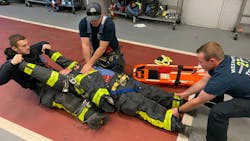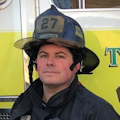“Mayday, mayday, mayday!” A firefighter goes down on the fireground, is rescued and brought to a safe location. Now what? Do we have the right emergency medical training and equipment nearby to truly save the life of one of our own? This could be a life-or-death moment for one of us. We must be well-versed and prepared for it. How would you feel if you had to explain to a fellow firefighter’s family that their death was preventable, but you failed them?
Yes, EMS comes to every working fire, but imagine a scenario where you are on the first-due engine company that’s called to a single-family dwelling fire with reported entrapment. While attacking the fire, you find an unconscious victim and quickly remove the individual. You then return inside and continue the fire attack. The victim is burned severely and has a compromised airway.
The first-arriving BLS ambulance immediately initiates patient care, places the victim into the ambulance and begins to drive toward the hospital, meeting an ALS unit on the way. Now, there are no other ambulances on scene because of a high call volume at the time of the fire. Suddenly, one of the firefighters who is on scene is bleeding severely after being cut by a large shard of broken glass. Now what? Who is going to help one of our own? What equipment is available? Unfortunately, I personally have seen a situation much like this occur.
I feel it’s safe to say that most firefighters didn’t join the fire department to provide emergency medical care, particularly in such a high call volume as many of us see annually. In fact, a fair amount of resentment toward EMS training often can be found within the fire service. Although I agree that EMS isn’t everyone’s cup of tea, I strongly believe that we must have quality basic emergency medical training and equipment—not only to treat patients but to treat us.
Culture change
How do we get there? First, we might need to change the culture within our respective firehouses and “sell” the fact that emergency medical care is extremely important—not only for our stakeholders but for one of our own. If you are hurt, who do you want treating you? The person with more training or less training?
A great example is from Black Sunday in New York City. On Jan. 23, 2005, three FDNY firefighters were killed in two separate fires, but it could have been worse. An FDNY firefighter/paramedic initiated lifesaving interventions on at least one down firefighter by performing the jaw-thrust maneuver to open the firefighter’s airway before EMS could get to the rear of the building. To me, this is reason enough as to why this is important to us.
Obviously, we must stay within our scope of practice, whatever that might be for your personnel, but here are some vital training topics that many of us can concentrate on within a basic life support-level system:
- High-performance firefighter down CPR
- BLS airway management
- Life-saving bleeding control
- Treatment of burns
- Movement of patients with a suspected spinal injury
Interventions as simple as keeping trauma and burn patients warm with blankets can be extremely beneficial. Time-sensitive interventions, such as maintaining an airway or applying a tourniquet, truly can save a life. When was the last time you practiced doing this?
Quality training
Not all training is good training. However, there are phenomenal EMS providers and instructors out there; you just have to put in some extra effort to find them and to use that resource for help with training. It will be worth it.
Much of this training can be performed indoors at the firehouse regardless of weather conditions. Like most things, these are perishable skills if not practiced consistently. With a little initiative and creativity, you can come up with realistic scenarios for drills. For example, on an extrication drill, you can have firefighters apply a tourniquet on a manikin that’s trapped inside of the vehicle. This isn’t overly complicated and can make training a little more dynamic and realistic.
Confidence
Patient care can be intimidating for some people, so learning in a realistic training environment can help to alleviate this problem. Additionally, you should conduct follow-ups on the hospital discharge summary of all of your patients when possible. This illustrates to EMS providers that they were right in their assessment and treatment and, thus, made for a positive patient outcome.
Equipment
I completely understand that one of the biggest hurdles for some departments when implementing a change is the initial cost of purchasing new equipment. Many fire and EMS organizations across the United States are underfunded and/or rely on the generosity of monetary donations from their residents for day-to-day costs. This is a sad reality. However, when prioritizing expenditures, money is no better spent than on the safety of our biggest asset, our personnel. Here is a list of some medical equipment to consider keeping on the fire apparatus at minimum:
- EMS jump bag
- Nitrile gloves
- Oxygen bottle
- Adult bag valve mask
- Assorted sizes of oropharyngeal airways
- Non-rebreather masks
- Nasal cannulas
- Trauma shears
- Adult c-collars
- Bleeding control equipment, such as tourniquets, hemostatic gauze, Israeli pressure bandages, trauma dressings, chest seals and roller gauze
- Two sets of adult AED pads
- Trauma shears
- Small roll of duct tape (for hair removal; plus, duct tape fixes everything)
- Cloth towel, approximately 12 x 24 inches (to dry off the chest prior to AED pad placement)
- Burn kit
- Portable suction unit that has a Yankauer suction tip and a backboard (note that the backboard in this case is advantageous to have when doing CPR—it’s a hard, flat surface—or when moving a patient)
Train to save ourselves
One of the great qualities of most firefighters is that they put the lives and well-being of others ahead of their own. Firefighters attend hundreds of hours of training to better themselves to serve the members of their community. Dedicating money, equipment and time to quality emergency medical training is just one important way that we can take care of us.
About the Author
Michael P. Wolfschmidt
Firefighter/EMT
Michael P. Wolfschmidt is a career firefighter/EMT in Westampton Township, NJ. Along with performing duties that range from Squad and Truck Company operations to EMS, he coordinates the training for the department as well. In addition, he works as a deputy district fire warden for the New Jersey Forest Fire Service. A fourth-generation fireman, he is a past chief and life member of the Surf City Volunteer Fire Company and EMS, where he started as a junior firefighter in 1998.

